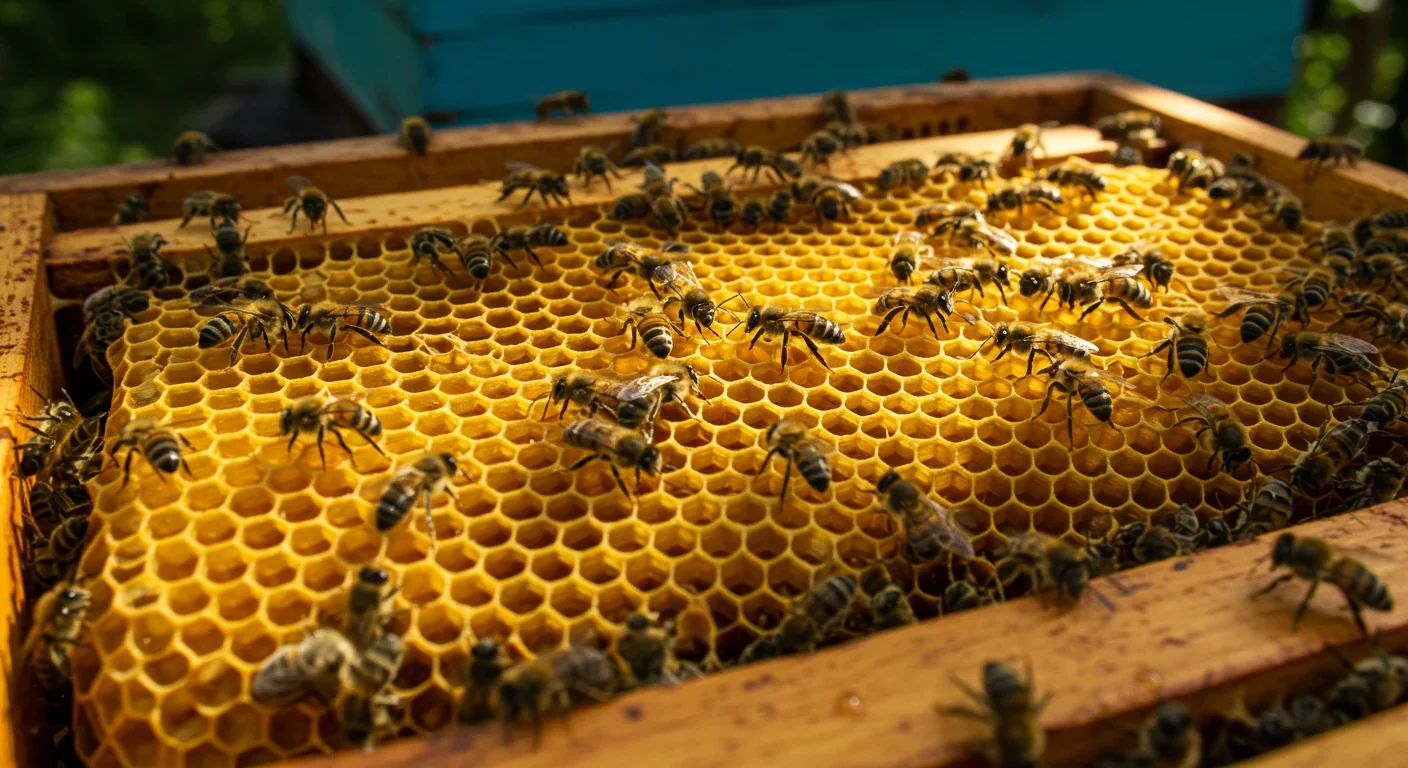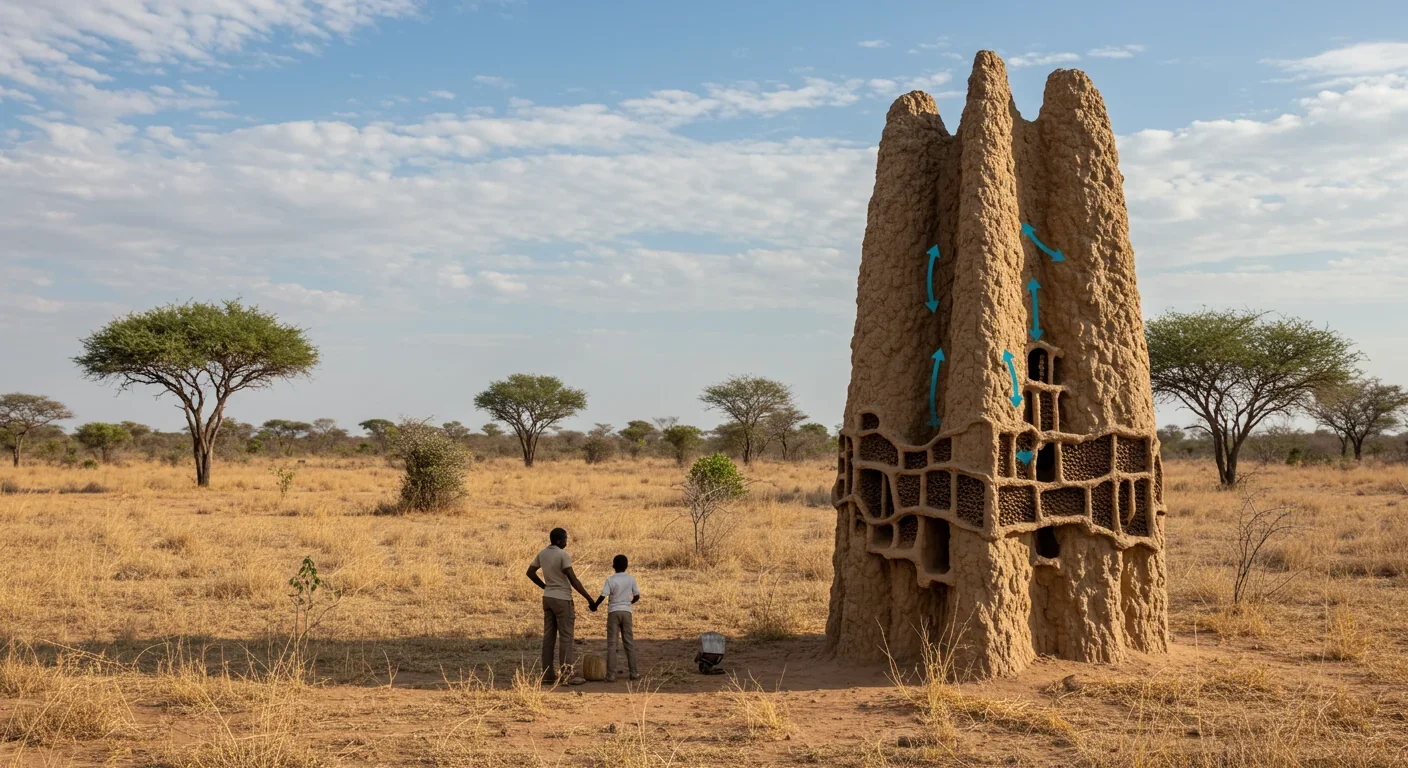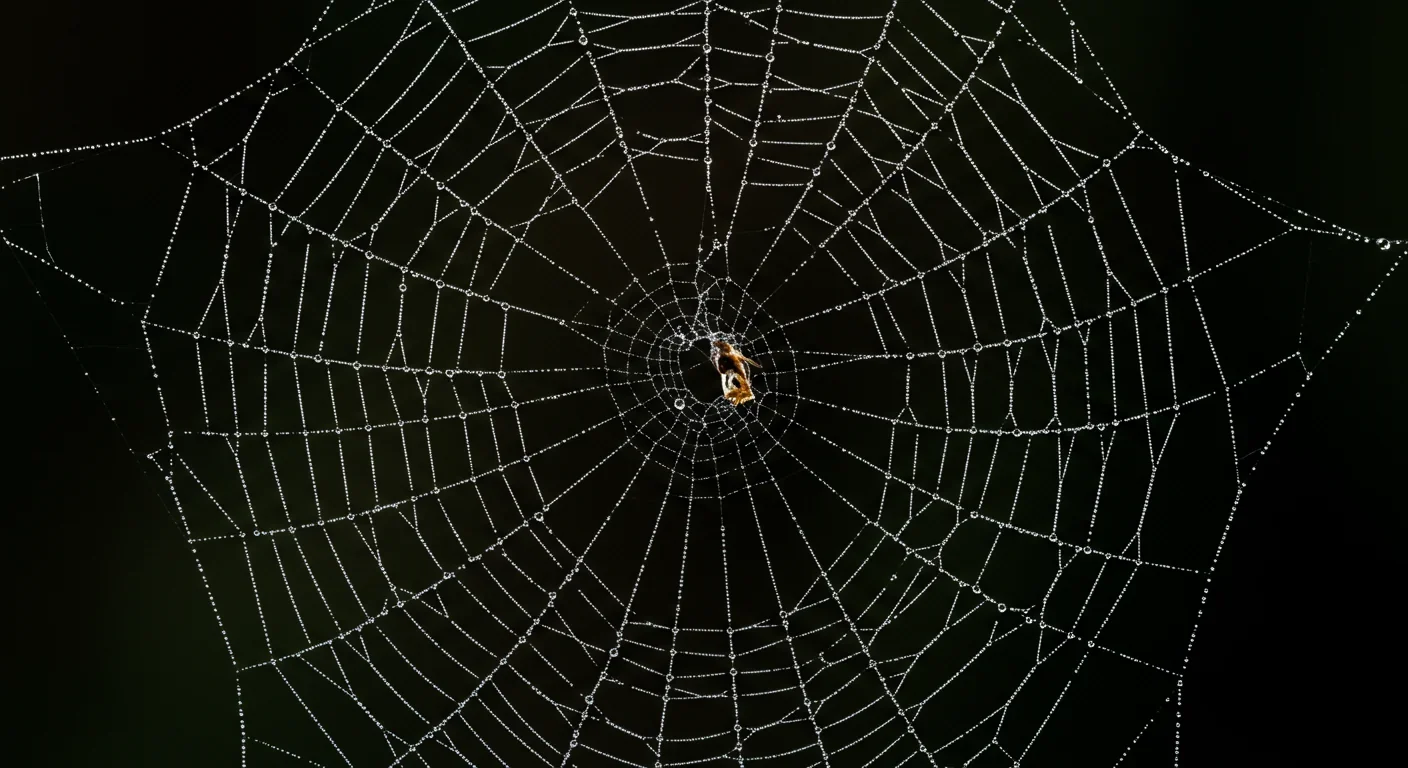Bombardier Beetle Chemical Defense: Nature's Micro Engine

TL;DR: Animals have spent millions of years perfecting architectural solutions that outperform human engineering—from bees' mathematically optimal hexagonal honeycombs to termites' zero-energy climate control systems. These natural blueprints are now inspiring breakthrough innovations in sustainable construction, materials science, and adaptive design.

Imagine a world where buildings cool themselves without air conditioning, bridges that repair their own cracks, and construction materials stronger than steel yet lighter than foam. That world already exists—but not in our labs or factories. For millions of years, animals have been solving engineering challenges that still baffle human designers, creating structures so efficient they make our greatest architectural achievements look primitive by comparison.
When honeybees construct their hives, they're not just building homes—they're solving one of mathematics' most elegant puzzles. The honeycomb conjecture, which stumped mathematicians for centuries, asks a deceptively simple question: what shape uses the least material to enclose the most space? After thousands of years of mathematical work, researchers finally proved in the late 1990s what bees figured out through evolution: the hexagon is perfect.
Here's what makes it remarkable. Bees produce wax by consuming honey—roughly eight ounces of honey for every ounce of wax. That honey represents about 2 million flower visits per pound. With that kind of metabolic cost, there's no room for waste. The hexagonal pattern maximizes storage while minimizing material, creating cells with wall thickness precise to within micrometers across entire hives.
What's even more astonishing is that bees don't start with hexagons. Recent research using X-ray microscopy revealed that worker bees initially create circular cells. As more cells cluster together, surface tension—the same force that shapes soap bubbles—transforms those circles into perfect hexagons. Physics, not genetics, drives the final geometry. The bees simply exploit fundamental forces that humans needed advanced mathematics to understand.
Traditional architecture requires detailed plans, but termite mounds demonstrate something far more sophisticated: emergent design. These towering structures, some reaching over 30 feet tall, maintain internal temperatures within a few degrees despite external swings of 60°F or more. They accomplish this through an intricate network of vents and channels that creates a passive air conditioning system requiring zero energy input.
The mechanics are brilliant. Hot air from the colony's metabolic activity rises through central chimneys while cooler air enters through lower vents. But here's the twist: termites constantly adjust the structure based on real-time feedback. If one section gets too warm, workers open new vents. Too cool? They seal passages. Each termite makes local decisions based on simple rules—humidity here, temperature there—yet collectively they produce a system that would require sophisticated sensors and controls if humans attempted to replicate it.
This principle of decentralized decision-making appears throughout nature's architecture. Francisco López Jiménez, an aerospace engineer studying bee construction, compares it to 3D printing: "The bees take turns, and they organize themselves, and we don't know how that happens." No foreman, no master plan, yet the final structure rivals human engineering in efficiency and surpasses it in adaptability.
Termites also demonstrate remarkable material innovation. They construct their mounds from a mixture of soil, saliva, and dung that hardens to the strength of concrete. The material is locally sourced, requires no industrial processing, and returns harmlessly to the ecosystem when the colony moves on. Meanwhile, human concrete production accounts for roughly 8% of global carbon emissions.

Spider webs represent perhaps nature's most audacious engineering feat: a structure that combines extreme strength with radical lightness. Dragline silk, the primary thread spiders use for web frames, has a tensile strength comparable to high-grade steel but weighs a fraction as much. A strand thick enough to catch a bumblebee weighs less than the bee's antenna.
The secret lies in protein architecture at the molecular level. Spider silk proteins contain highly ordered crystalline regions that provide strength, interspersed with amorphous regions that allow flexibility. This combination creates a material that can stretch up to 40% of its length before breaking—absorbing energy that would shatter rigid materials.
Different spider species produce multiple silk types for different purposes, each with distinct mechanical properties. Orb weavers, for instance, use stiff dragline silk for the web's radial spokes but employ highly elastic capture silk for the spiral—creating a structure that can absorb the impact of flying insects without tearing. They're essentially building composite materials with performance characteristics tailored to specific structural demands.
Humans have tried for decades to replicate spider silk industrially. The challenge isn't understanding the chemistry—we can now synthesize spider silk proteins—but matching the processing. Spiders produce silk at room temperature using water-based solutions. Our best efforts require high heat, toxic solvents, and still fall short of natural silk's properties. Nature achieves with elegance what we can only approximate through brute force.
The gap between admiring natural design and actually implementing it has been closing rapidly. Masdar City in Abu Dhabi, an urban development designed for sustainability, directly mimics termite mound ventilation. The city's buildings use passive cooling systems that reduce air conditioning demands by up to 70%—a crucial advantage in one of the world's hottest climates.
Similarly, the Al Bahar Towers in Abu Dhabi feature a responsive facade inspired by plant movements. Computer-controlled panels open and close based on sun position, reducing heat gain by 50% compared to conventional glass buildings. The system responds dynamically, much like flowers tracking sunlight, rather than relying on fixed shading that only works optimally at certain times.
Aerospace engineering has been particularly eager to adopt biological inspirations. Honeycomb core panels—sandwich structures with hexagonal cells between thin face sheets—are now standard in aircraft construction. They provide excellent strength-to-weight ratios, critical when every pound affects fuel efficiency. The aviation industry essentially borrowed a 100-million-year-old bee patent.
Material science is following suit. Researchers are developing spider web-inspired composites that mimic the crystalline-amorphous structure of natural silk. Early results show materials that can absorb impact energy far better than conventional composites—potentially revolutionizing everything from car bumpers to bulletproof vests.
Even construction methods are evolving. A 2025 study published in PLOS Biology examined how bees adapt their building techniques when working with irregular foundations. Researchers provided 3D-printed panels with varying cell sizes and watched as bees merged cells, tilted them at angles, or layered them vertically to compensate. Lead researcher Orit Peleg notes this could inspire swarm robotics: autonomous construction teams that adapt to unpredictable conditions without central control.
Despite obvious benefits, biomimicry faces significant barriers to widespread implementation. A recent study of UAE construction stakeholders identified knowledge gaps, regulatory hurdles, and perceived risks as primary obstacles. Architects and engineers trained in conventional methods may lack the interdisciplinary knowledge to translate biological principles into built systems. Building codes, written for traditional materials and methods, often don't accommodate novel approaches.
There's also an economic calculation. Biomimetic designs may reduce long-term operating costs but can increase initial construction expenses. In markets focused on upfront costs rather than lifecycle value, this creates a difficult pitch. Developers want proof of performance before committing, but proof requires implementation—a classic chicken-and-egg problem.
Risk aversion compounds the challenge. Construction is conservative by necessity; failures can be catastrophic. Natural systems have been tested by millions of years of evolution, but their human-designed analogs lack that track record. What happens when biomimetic ventilation systems face conditions outside their tested range? Who's liable if a novel material fails? These questions don't have easy answers.
The path forward likely requires policy intervention. Green building standards could prioritize biomimetic approaches. Government funding could support demonstration projects that prove concepts at scale. Educational reform could train a generation of designers fluent in both biological and engineering principles.

What makes animal architecture so compelling isn't just efficiency—it's adaptability. Human structures are static. We design for expected conditions and hope reality cooperates. Natural structures evolve continuously, responding to changing environments through feedback and iteration.
Consider how termites handle damage. If you punch a hole in a mound, workers immediately begin repairs, but they don't just patch the gap. They assess airflow changes, temperature shifts, and structural stress, then rebuild in a way that often improves on the original design. The structure learns from disturbance.
This principle extends to materials. Many biological materials can self-repair. Spider silk, if partially damaged, can reweave connections at the molecular level. Human materials either break or require external intervention to fix. We're starting to develop self-healing concrete and polymers, but these technologies draw direct inspiration from biological precedents.
The implications reach beyond individual structures. Ecosystems demonstrate how multiple elements can integrate into resilient, self-sustaining systems. Coral reefs support enormous biodiversity while building massive limestone structures entirely from ambient materials. Forests regulate local climate, water cycles, and nutrient flows while producing building materials as a byproduct of normal growth. These aren't analogies—they're working models for how human civilization might eventually operate.
We're approaching an inflection point where biological inspiration shifts from novelty to necessity. Climate change demands buildings that use far less energy. Resource scarcity requires materials that can be produced renewably. Growing populations need construction methods that scale without proportional environmental impact. Nature has solved all these problems already.
The technical barriers are falling. Advanced imaging techniques let researchers examine biological structures at molecular resolution. Computational modeling can simulate how natural designs perform under various conditions. Additive manufacturing enables production of complex geometries impossible with traditional methods. We now have the tools to not just study nature's architecture but implement it.
The biomimetic materials market is projected to grow significantly over the next decade as these technologies mature. Applications range from medical implants that integrate with living tissue to building facades that adapt to weather in real time. We're not just copying nature anymore—we're learning its design principles and applying them to challenges nature never faced.
Perhaps most exciting is what this means for construction's future. Instead of armies of workers following rigid plans, imagine swarms of robots making local decisions based on environmental feedback, collectively building structures that self-optimize. Instead of demolishing old buildings and sending material to landfills, imagine structures designed from the start to decompose safely or be fully reclaimed. Instead of fighting nature with brute force engineering, imagine working with natural processes to create built environments that enhance rather than degrade ecosystems.
The evidence is overwhelming: animals are better architects than humans, at least by the metrics that matter most—efficiency, sustainability, adaptability, and resilience. Bees solve optimization problems that challenged mathematicians for millennia. Termites build passive climate control systems that would require sophisticated electronics to replicate. Spiders produce materials whose strength-to-weight ratios exceed our best industrial efforts.
The question isn't whether we should learn from nature's engineers. It's how quickly we can scale those lessons across the built environment. Every biomimetic building demonstrates what's possible. Every successful application proves the concept and builds confidence for the next innovation.
The path ahead requires humility—acknowledging that evolution is a design process far more sophisticated than any human architect can match—and ambition to actually implement what nature teaches. It demands interdisciplinary collaboration, bringing together biologists, engineers, architects, and materials scientists who can translate between natural and artificial systems.
Most of all, it requires a shift in perspective. We've spent centuries trying to conquer nature through engineering. The future belongs to those who recognize nature as engineering—and the greatest mentor we could ask for. Animals have been running the world's most successful architecture firm for hundreds of millions of years. It's time we became their apprentices.

Recent breakthroughs in fusion technology—including 351,000-gauss magnetic fields, AI-driven plasma diagnostics, and net energy gain at the National Ignition Facility—are transforming fusion propulsion from science fiction to engineering frontier. Scientists now have a realistic pathway to accelerate spacecraft to 10% of light speed, enabling a 43-year journey to Alpha Centauri. While challenges remain in miniaturization, neutron management, and sustained operation, the physics barriers have ...

Epigenetic clocks measure DNA methylation patterns to calculate biological age, which predicts disease risk up to 30 years before symptoms appear. Landmark studies show that accelerated epigenetic aging forecasts cardiovascular disease, diabetes, and neurodegeneration with remarkable accuracy. Lifestyle interventions—Mediterranean diet, structured exercise, quality sleep, stress management—can measurably reverse biological aging, reducing epigenetic age by 1-2 years within months. Commercial ...

Data centers consumed 415 terawatt-hours of electricity in 2024 and will nearly double that by 2030, driven by AI's insatiable energy appetite. Despite tech giants' renewable pledges, actual emissions are up to 662% higher than reported due to accounting loopholes. A digital pollution tax—similar to Europe's carbon border tariff—could finally force the industry to invest in efficiency technologies like liquid cooling, waste heat recovery, and time-matched renewable power, transforming volunta...

Humans are hardwired to see invisible agents—gods, ghosts, conspiracies—thanks to the Hyperactive Agency Detection Device (HADD), an evolutionary survival mechanism that favored false alarms over fatal misses. This cognitive bias, rooted in brain regions like the temporoparietal junction and medial prefrontal cortex, generates religious beliefs, animistic worldviews, and conspiracy theories across all cultures. Understanding HADD doesn't eliminate belief, but it helps us recognize when our pa...

The bombardier beetle has perfected a chemical defense system that human engineers are still trying to replicate: a two-chamber micro-combustion engine that mixes hydroquinone and hydrogen peroxide to create explosive 100°C sprays at up to 500 pulses per second, aimed with 270-degree precision. This tiny insect's biochemical marvel is inspiring revolutionary technologies in aerospace propulsion, pharmaceutical delivery, and fire suppression. By 2030, beetle-inspired systems could position sat...

The U.S. faces a catastrophic care worker shortage driven by poverty-level wages, overwhelming burnout, and systemic undervaluation. With 99% of nursing homes hiring and 9.7 million openings projected by 2034, the crisis threatens patient safety, family stability, and economic productivity. Evidence-based solutions—wage reforms, streamlined training, technology integration, and policy enforcement—exist and work, but require sustained political will and cultural recognition that caregiving is ...

Every major AI model was trained on copyrighted text scraped without permission, triggering billion-dollar lawsuits and forcing a reckoning between innovation and creator rights. The future depends on finding balance between transformative AI development and fair compensation for the people whose work fuels it.